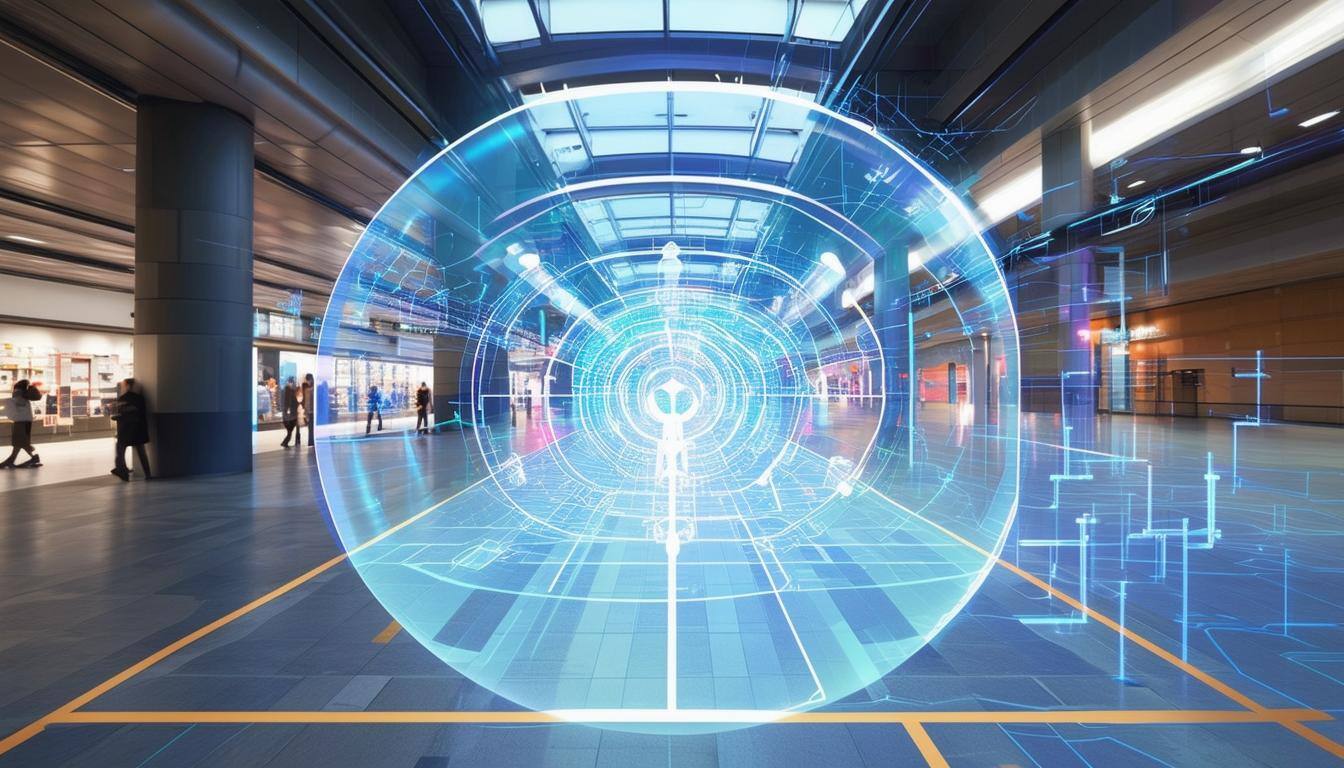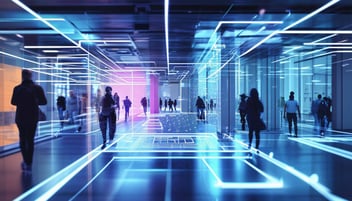< Back to the AR Wayfinding Guide
The 5 Most Exciting AR Wayfinding Technologies Now In Development
From sprawling shopping malls to intricate museum corridors, AR wayfinding technologies are already reshaping how people navigate complex indoor environments. But while current offerings are impressive, the future holds even more promise.
This article explores prospective features of AR wayfinding technologies that are currently in developmental stages and how they could redefine indoor navigation.
- Personalized Navigation Experiences
- Semantic AR Wayfinding
- Haptic & Multisensory Feedback
- Collaborative Wayfinding
- AI-Powered Predictive Navigation

1. Personalized Navigation Experiences
Today’s AR wayfinding solutions are often limited to displaying arrows or markers guiding users from Point A to Point B. In the future, navigation could become deeply personalized. Imagine a system that doesn’t just lead you to your destination but adapts the route based on your preferences, habits, emotions, and real-time conditions.
For instance, a shopper entering a mall might be offered a route past their favorite store because its cycled in new stock since their last recorded visit or avoiding crowded areas based on live foot-traffic data.
Such systems could use machine learning models trained on user behavior patterns and preferences to deliver an unimaginably relevant experience for each user. By integrating user profiles with real-time environmental data, AR wayfinding could shift from a functional tool to a virtual companion.
2. Semantic AR Wayfinding
One of the most exciting prospects for AR wayfinding lies in semantic understanding. Current AR systems often rely on pre-defined markers or maps to guide users, but semantic AR would take this further by understanding the context and meaning of spaces in real-time.
For example, in a corporate campus or hospital, semantic AR could recognize and interpret unmarked areas such as temporary setups, maintenance zones, or evolving layouts. By integrating advancements in computer vision and natural language processing, these systems could overlay labels or directions based on what the camera detects and how it interprets these visuals. In an airport, semantic AR could identify and highlight the nearest check-in counters or gate changes on-the-fly without relying on pre-configured layouts.
3. Haptic and Multisensory Feedback
While visual overlays are currently the centerpiece of AR navigation, the future may expand to include multisensory feedback, such as haptic vibrations or audio cues. This could be particularly impactful for the elderly or for those navigating busy, visually overwhelming environments.
Research is already exploring wearable devices that provide directional feedback through vibrations or temperature changes on the skin. Imagine a scenario where your AR glasses guide you visually, while a subtle pulse on your wristband ensures you don’t miss a turn. For an immersive experience, spatial audio could further assist, with directional sounds calling users toward their destination.
4. Collaborative Wayfinding
AR wayfinding in the future could also incorporate collaborative elements, allowing multiple users to share navigation experiences or work together in real-time. For instance, colleagues attending a large convention center might connect their devices to see each other’s locations and collaboratively map out a meeting point.
This could also extend to professional applications, such as emergency response teams using shared AR wayfinding to coordinate efforts in disaster zones or large buildings. A team leader could overlay a real-time map on their AR headset, tracking team members' locations and assigning routes or tasks on the fly.
5. AI-Powered Predictive Navigation
While AR navigation today is largely reactive—responding to where you are and where you want to go—future systems could be predictive, anticipating needs and suggesting routes before users even request them.
This capability could leverage real-time data streams from IoT sensors, traffic reports, and user calendars. For example, as you leave a meeting, your AR system might proactively suggest a route to your next appointment, factoring in time constraints and expected delays. In a retail environment, it might guide you to the checkout counter at the optimal time, maximising shopping time and avoiding long lines.
Predictive navigation would be especially valuable in dynamic environments like airports or theme parks, where conditions change rapidly. By continuously analyzing data, AR systems could provide not just the fastest route but the smartest one.
The Three Hurdles To Overcome
While these five advancements are tantalizing, three significant hurdles must be passed; hardware design, software development, and data privacy.
AR devices themselves must become more lightweight, battery-efficient, and affordable to achieve mass adoption. Elsewise, already popular devices such as smartphones must evolve to better accommodate AR. Meanwhile, the software must handle immense computational demands while maintaining real-time performance.
Data privacy is the final concern. Future AR systems will likely rely heavily on personal data, such as location histories, preferences, and habits, to deliver personalized and predictive navigation. Ensuring that this data is collected, stored, and used responsibly will be crucial to gaining user trust.
Final Thoughts
For all businesses, now is the time to explore and invest in these technologies, ensuring they are prepared to lead in a future where AR is seamlessly integrated into everyday life.
The journey to realizing this vision is just beginning, but the destination promises to be extraordinary.
See also: The 5 Best AR Wayfinding Technologies On The Market Right Now
Updated on March 14, 2025
by Joshua Simpson


